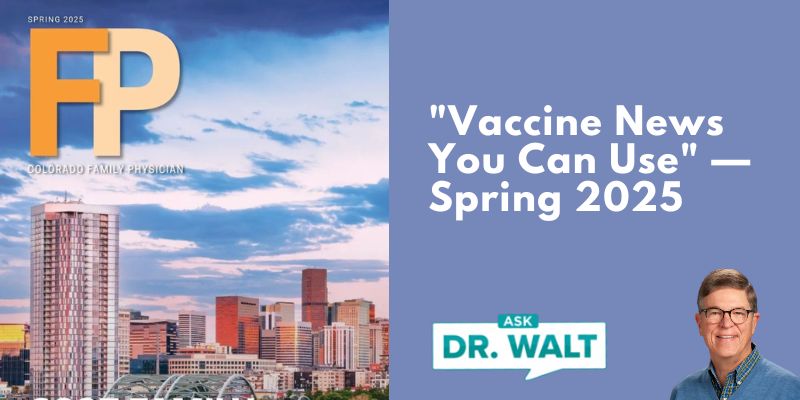
April 13-15, 1945 — Phil writes home and FDR dies
April 13, 2025
“Vaccine News You Can Use” for Family Physicians (Part 2) — Spring 2025
April 16, 2025I’ve been honored to write a quarterly column, “Vaccine News You Can Use” for the Colorado Family Physician (CFP) journal for a number of years. Below is Part 1 of my Spring 2025 column..
Part 1 of my Spring 2025 column in the CAFP journal can be viewed here on pages 26-28; however, I’ve also posted it as a blog below. Part 2 of the column will be posted here on 4/13/25.
~~~~~
Colorado adults may soon be vulnerable to ‘childhood’ diseases
The New York Times reported, more than 32,000 cases of whooping cough in 2024, the highest tally in a decade. The CDC is reporting that in 2024 the US had the most whooping cough fatalities since the surge of 2017, with the most recent count being up 27%. Pertussis is perhaps the starkest example of what happens to primarily unvaccinated or incompletely vaccinated people when vaccination rates decline. But it is far from the only one. Another is the current outbreak of measles with infections confirmed in at least five states –Alaska, Georgia, New York City, Rhode Island, and Texas. Nearly every case is in people who are unvaccinated or whose status is unknown .
The Times noted, “The pandemic interrupted childhood immunizations across the country, and rates have not yet recovered. As a result, hundreds of thousands of children are increasingly vulnerable to diseases once largely relegated to history books. Most of them predominantly affect young children, like measles, mumps, and rubella. But if immunizations continue to fall over the next few years — because of rising distrust or more restrictive federal policies — preventable infectious diseases will resurface in all age groups. It’s not just the unvaccinated who will have to worry. Even adults who were vaccinated decades ago may find themselves vulnerable to what are now considered childhood diseases. Unfortunately, most people have forgotten the dangers of childhood diseases.”
As we all know, high vaccination rates in a community protect not just the vaccinated, but also people who cannot receive some vaccines or who may not respond to them because of certain medical conditions, their age, or weakened immune systems. Yet, as immunization rates fall in some areas and among some groups in Colorado and fewer people are vaccinated, the unvaccinated are making an active decision to make our state a less safe place for a significant proportion of the population to which they are around.
The Times noted, “The past offers a preview: In the late 1980s, budget cuts by the Reagan administration brought down vaccination rates, particularly among low-income Black and Hispanic children. The fallout was swift. From 1989 through 1991, measles infected more than 55,000 Americans and killed 166. A 2015 study estimated that before widespread vaccination, measles may have accounted for as many as half of all infectious disease deaths in children. Even now, the consequences can be serious. About 40 percent of people infected last year were hospitalized, according to the CDC.” In Colorado, during the 2023-2024 school year, among children enrolled in kindergarten, 11.7% were not up to date with MMR vaccination and another 4.2 percent had exemptions.
Another potential example is rubella, or German measles, that can be dangerous for pregnant women and their babies. Yet pregnant women cannot be immunized against the disease because the vaccine contains a weakened live virus. These days, our pregnant patients are typically not at risk, because there are fewer than a dozen rubella cases in the US each year. However, that could change if vaccination rates continue to drop. Outside of the US, rubella is the leading vaccine-preventable cause of birth defects. The virus is extraordinarily contagious, lingering in the air for up to two hours after an infected person has left the room. Each infected person can spread the virus to as many as 18 others. Furthermore, when a nonimmune pregnant woman catches rubella, then her unborn baby is at risk for death or the lifelong complications of cataract, blindness, heart defects, or deafness. When I was in my fellowship in England in the late 1970’s, I saw several of these “rubella babies” in the nursery. Each one was heartbreaking, and each one was preventable.
But pertussis is the illness that we FPs should be most aware of in our practices – even among vaccinated children and adults. Tdap, introduced in the 1990s, provides decades of protection against severe disease; however, it does not fully prevent non-fatal infections as the protection wanes over time. It can be mistaken for a typical URI at first, but then bloom into a painful, full-body “100-day cough.” As pertussis cases rise, many in the public are not familiar with symptoms of the disease. One survey (tinyurl.com/ybrkjj8m) found that almost a third of Americans (30%) are not sure if pertussis is the same as whooping cough (it is) and are not sure whether a vaccine exists to prevent it (it does). If the pertussis vaccination rates were to continue to fall, those who received the whole-cell DPT vaccine before 1996 might still be protected, but the unimmunized and adults who only received the Tdap vaccine might be susceptible.
The bottom line is that it would be wise for all of Colorado’s FPs to strive to have complete vaccination records on all their patients and for each of us to educate, equip, and enable our staff to assist us is assuring that as many are as fully vaccinated as possible.
CME Question #1:
What percentage of people are (1) not sure if pertussis is the same as whooping cough and (2) not sure whether a vaccine exists to prevent it?
- 10%
- 20%
- 30%
- 40%
- 50%
A new clinical decision support tool for immunizations
A group of experts advise us: “There are tools to help bring vaccine administration within guidelines, pointing to the CDC’s Clinical Decision Support for Immunizations (CDSi) technology that can be integrated into electronic health and other systems to help health professionals make accurate recommendations at the point of care.” The authors advise that this technology “should be used in all settings where children get vaccines.” I would think the same would be true in settings where the entire family receives care from FPs. If you use this, or do in the future, let me know so I can report on it.
CME Question #2:
There are software tools available from the CDC to help bring vaccine administration to within guidelines.
- True
- False
Most adults, particularly parents, trust and follow their doctor’s vaccine recommendations
Medical Economics reported the results of a poll of US voters revealing an overwhelming majority of American voters, 74%, support maintaining broad access to FDA-approved vaccines—a sentiment that crossed political lines. The respondents had near-universal trust in their health professionals with more than half placing “a great deal of weight” on their physician’s opinion regarding vaccine decisions – a figure that rises even further among parents with 88% reporting that they always or sometimes vaccinate their children based on their physician’s recommendations, while 77% of respondents said they follow the same guidance for themselves. The authors concluded, “It’s important to recognize that, despite political differences, Americans recognize a fundamental need to protect themselves, their families, and their communities through vaccines.”
CME Question #3:
Most Americans support maintaining access to FDA-approved vaccines and place a great deal of weight on their physician’s opinions regarding vaccine decision.
- True
- False
Too many children still lack the necessary doses to complete vaccine series
An analysis of CDC immunization data from 2011 through 2020 published in Pediatrics reported on of children ages 35 months and younger who had at least one invalid vaccine dose (defined as receiving a vaccine younger or older than the recommended age, sooner than the recommended interval between dose) had dropped from 17% in 2011 to 12% in 2020. Even better, the proportion that completed all series increased from 29% in 2011 to 53% in 2020. Children with multiple health professionals or moved were more likely to receive invalid doses. My guess is that we FPs would fare much better than this. Nevertheless, for with invalid doses, the ACIP recommends repeating vaccinations to meet guidelines. The authors noted, “Invalid doses that are not repeated may leave children vulnerable to vaccine-preventable diseases and contribute to lowered disease protection in communities.”
CME Question #4:
What percentage of children ages 35 months and younger completed the recommended series of vaccinations?
- 53%
- 63%
- 73%
- 83%
- 93%
FDA adds warning on two RSV vaccines about risk of rare neurologic disorder
The FDA issued a safety communication that warns about possible Guillain-Barré syndrome (GBS) with the RSV vaccines manufactured by Pfizer (Abrysvo) and GSK (Arexvy). However, the study estimated the excess cases of GBS in people 65 or older were only nine per million doses of Abrysvo and seven per million doses of Arexvy. Nevertheless, a third approved product, Moderna’s mRNA vaccine (mResvia) was not included in the safety warning. A single dose of RSV vaccine is recommended for all adults ages 75 years and older, as well as for 60- to 74-year-olds who are at increased risk of severe illness from the virus.
CME Question #5:
What is the estimated risk of Guillain-Barré syndrome (GBS) with the RSV vaccines manufactured by Pfizer (Abrysvo) and GSK (Arexvy)?
- 7-9 per million doses
- 7-9 per one hundred thousand doses
- 7-9 per ten thousand doses
- 7-9 per thousand doses
- 7-9 per one hundred doses
Seasonal flu shot may be the first defense against an avian influenza pandemic
In a prospective observational study, immune protection against an H7N9 bird flu (AIV) was almost absent prior to a flu vaccination. However, seasonal flu vaccines induced a seroprotective response against the H5N1 bird flu in nearly 15% of younger individuals. The authors opined, “Probably the best vaccination strategy during the early stages of an AIV pandemic will likely involve immunization first with seasonal inactivated flu vaccine, followed, when it becomes available, with an AlV-specific vaccine.”
CME Question #6:
A yearly influenza vaccine will provide no protection against avian influenza.
- True
- False
Answer Key: 1 = 1, 2 = 1, 3 = 1, 4 = 1, 5 = 1, 6 = 2
Abbreviations used in Parts 1 & 2 of the column:
- ACIP – Advisory Committee for Immunization Practices
- AIV – avian influenza virus
- Bacillus Calmette-Guérin (BCG) vaccine
- CDC – Centers for Disease Control and Prevention
- CDSi – CDC’s Clinical Decision Support for Immunizations (CDSi)
- CME – Continuing Medical Education
- COVID – COVID-19, SARS-CoV-2
- DPT – tetanus, diphtheria, and whole-cell pertussis vaccine, also called DTwP, not available in the US since 1996
- DTaP – tetanus, diphtheria, and acellular pertussis vaccine for infants and young children
- FDA – US Food and Drug Administration
- FPs – family physicians
- GBS – Guillain-Barré syndrome
- H5N1 – a subtype of avian influenza A virus or bird flu
- H5N9 – a subtype of avian influenza A virus or bird flu
- flu – influenza
- MMR – measles, mumps, and rubella
- mRNA – messenger ribonucleic acid
- RFK – Robert F. Kennedy
- RSV – respiratory syncytial virus
- SARS-CoV-2 – severe acute respiratory syndrome coronavirus 2
- Tdap – tetanus, diphtheria, and acellular pertussis vaccine for older children and adults
- URI – upper respiratory infection
- US – United States
- ACIP – Advisory Committee for Immunization Practices
- AIV – avian influenza virus
- Bacillus Calmette-Guérin (BCG) vaccine
- CDC – Centers for Disease Control and Prevention
- CDSi – CDC’s Clinical Decision Support for Immunizations (CDSi)
- CME – Continuing Medical Education
- COVID – COVID-19, SARS-CoV-2
- DPT – tetanus, diphtheria, and whole-cell pertussis vaccine, also called DTwP, not available in the US since 1996
- DTaP – tetanus, diphtheria, and acellular pertussis vaccine for infants and young children
- FDA – US Food and Drug Administration
- FPs – family physicians
- GBS – Guillain-Barré syndrome
- H5N1 – a subtype of avian influenza A virus or bird flu
- H5N9 – a subtype of avian influenza A virus or bird flu
- flu – influenza
- MMR – measles, mumps, and rubella
- mRNA – messenger ribonucleic acid
- RFK – Robert F. Kennedy
- RSV – respiratory syncytial virus
- SARS-CoV-2 – severe acute respiratory syndrome coronavirus 2
- Tdap – tetanus, diphtheria, and acellular pertussis vaccine for older children and adults
- URI – upper respiratory infection
- US – United States
© Copyright WLL, INC. 2025. This blog provides healthcare tips and advice you can trust about a wide variety of general health information only and is not intended to substitute for professional medical advice, diagnosis, or treatment from your regular physician. If you are concerned about your health, take what you learn from this blog and meet with your personal doctor to discuss your concerns.



